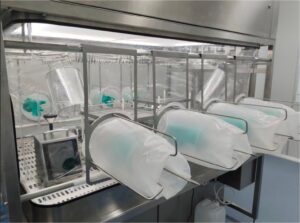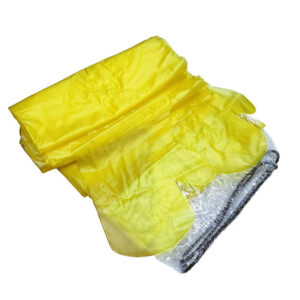Установка и обслуживание высокоэффективных воздушных фильтров - один из наиболее важных аспектов эксплуатации чистых помещений и управления качеством воздуха в них. Независимо от того, управляете ли вы фармацевтическим производством, чистым помещением для полупроводников или медицинским учреждением, надлежащая установка воздушного фильтра напрямую влияет на эффективность работы, соблюдение стандартов и долгосрочное управление затратами.
Сложность современных систем фильтрации означает, что даже незначительные ошибки при установке могут ухудшить качество воздуха, увеличить потребление энергии до 25% и привести к преждевременному выходу фильтра из строя. Неправильные протоколы технического обслуживания часто приводят к незапланированным простоям, нарушениям нормативных требований и расходам на замену, которые могут превышать $50 000 в год для крупных объектов.
В этом комплексном руководстве представлены практические процедуры установки, проверенные стратегии обслуживания и систематические подходы к устранению неисправностей, обеспечивающие оптимальную работу фильтра. Вы узнаете о методах профессионального уровня, передовом опыте и экономически эффективных решениях, которые позволят вам максимально увеличить инвестиции в фильтрацию и сохранить строгие стандарты качества воздуха.
Что такое установка высокоэффективного воздушного фильтра и почему она имеет значение?
Установка высокоэффективных воздушных фильтров включает в себя точное размещение, герметизацию и интеграцию фильтров HEPA и ULPA в системы контролируемой среды. Этот процесс требует тщательного внимания к выравниванию рамы, сжатию прокладок и распределению воздушного потока для достижения заданной эффективности удаления частиц.
Понимание классификаций эффективности фильтров
Современные высокоэффективные фильтры работают в нескольких классах эффективности, каждый из которых предназначен для выполнения конкретных требований по контролю загрязнений. Фильтры HEPA достигают эффективности 99,97% для частиц размером 0,3 микрон, а фильтры ULPA - 99,999% для еще более мелких загрязнений. Процесс установки должен сохранять эти показатели эффективности благодаря правильным методам обращения и герметизации.
Промышленные данные показывают, что правильно установленные фильтры HEPA сохраняют свою номинальную эффективность в течение 12-18 месяцев при нормальных условиях эксплуатации. Однако дефекты установки могут снизить эффективность фильтрации на 15-40%, что негативно сказывается как на качестве воздуха, так и на энергоэффективности.
Критические параметры установки
Профессиональная установка требует точного измерения размеров рамы, выбора материала прокладки и расчета усилия сжатия. Допуски корпуса фильтра обычно составляют от ±0,5 мм до ±2 мм, в зависимости от сложности применения. Любое отклонение за пределы этих спецификаций может привести к образованию обходных путей, позволяющих нефильтрованному воздуху обходить фильтрующую среду.
По словам специалистов по контролю загрязнений, "каждый миллиметр неправильного выравнивания уплотнений может снизить общую эффективность системы на 2-3%, что со временем приводит к усугублению последствий".
YOUTH Clean Tech подчеркивает, что точность установки напрямую связана с долгосрочной надежностью работы и управлением эксплуатационными расходами.
Как правильно выбрать HEPA-фильтр для чистых помещений?
Выбор подходящей технологии фильтрации требует всестороннего анализа распределения частиц по размерам, требований к воздушному потоку и условий окружающей среды. Это решение влияет не только на успешность первоначальной установки, но и на требования к текущему обслуживанию и долговечность системы.
Критерии выбора фильтров для конкретного применения
Различные классификации чистых помещений требуют различных подходов к фильтрации. Для помещений класса 5 по ISO обычно требуются фильтры HEPA с эффективностью 99,99%, в то время как для помещений класса 3 по ISO может потребоваться фильтрация ULPA. Понимание этих требований позволяет избежать завышения спецификации, что увеличивает расходы, или занижения спецификации, что ставит под угрозу соответствие требованиям.
| Класс чистых помещений | Минимальная эффективность фильтра | Типовые применения | Частота замены |
|---|---|---|---|
| ISO 5 | 99.97% HEPA | Фармацевтика, электроника | 12-18 месяцев |
| ISO 4 | 99.99% HEPA | Медицинские приборы, полупроводники | 18-24 месяца |
| ISO 3 | 99.999% ULPA | Передовые исследования, нанотехнологии | 24-36 месяцев |
Оценка экологической совместимости
Перепады температуры, уровень влажности и воздействие химических веществ существенно влияют на выбор фильтрующего материала. Стандартный плиссированный материал хорошо работает при температуре до 70°C, в то время как для специализированных применений могут потребоваться керамические или металлические фильтрующие элементы, способные выдерживать температуру 200°C и выше.
Химическая совместимость имеет решающее значение в фармацевтической и химической промышленности. Высокоэффективные воздушные фильтры Разработанные для таких применений, они оснащены химически стойкими прокладками и коррозионностойкими рамами для предотвращения разрушения.
Учет расхода воздуха и перепада давления
Для правильного выбора размера требуется точный расчет расхода воздуха и анализ перепада давления. Неразмерные фильтры создают чрезмерный перепад давления, увеличивая потребление энергии и потенциально вызывая повреждение фильтрующего материала. Установка слишком больших фильтров может привести к неравномерному распределению воздушного потока и снижению эффективности фильтрации.
Профессиональные установки обычно поддерживают перепад давления в пределах 125-250 Па для фильтров HEPA и 200-400 Па для фильтров ULPA. Эти параметры обеспечивают оптимальную производительность при минимальном потреблении энергии.
Каковы основные этапы профессиональной установки воздушного фильтра?
Систематические процедуры установки обеспечивают правильное расположение фильтра, достаточную герметичность и оптимальное распределение воздушного потока. Следование стандартным протоколам сокращает время установки, предотвращает распространенные ошибки и максимально повышает эффективность работы фильтра.
Подготовка и проверка перед установкой
Начните с тщательного осмотра корпуса фильтра, поверхностей прокладок и крепежных деталей. Очистите все контактные поверхности с помощью соответствующих растворителей и безворсовых материалов. Убедитесь, что размеры корпуса соответствуют техническим характеристикам фильтра, обращая особое внимание на радиусы углов и выравнивание монтажных отверстий.
Обращение с фильтрами требует внимательного отношения, чтобы не повредить хрупкие складчатые материалы. Используйте правильные методы подъема и избегайте контакта с поверхностями фильтров. До установки храните фильтры в оригинальной упаковке, чтобы предотвратить загрязнение или физическое повреждение.
Процедуры установки и уплотнения прокладок
Выбор и установка прокладок существенно влияют на производительность и долговечность фильтра. Неопреновые прокладки хорошо подходят для стандартных применений, в то время как силиконовые или тефлоновые прокладки могут потребоваться в условиях высоких температур или химического воздействия.
Равномерно накладывайте прокладки по периметру фильтра, обеспечивая равномерное сжатие. Чрезмерное сжатие может привести к выдавливанию прокладок и деформации каркаса фильтра, в то время как недостаточное сжатие создает обходные пути. Коэффициент сжатия обычно составляет 20-30% от первоначальной толщины прокладки.
Специалисты по установке рекомендуют "проводить предварительную проверку посадки перед окончательной затяжкой, чтобы выявить потенциальные проблемы с выравниванием, которые могут нарушить целостность уплотнения".
Окончательная проверка установки и тестирования
Закрепите фильтры, используя указанные производителем значения крутящего момента, обычно 5-8 Нм для стандартных крепежных винтов. Соблюдайте последовательность затяжки по схеме "звезда", чтобы обеспечить равномерное распределение давления по каркасу фильтра.
Проведите проверку герметичности с помощью соответствующих методов, таких как испытание DOP или подсчет частиц. Эта проверка подтверждает соответствие установки проектным спецификациям и выявляет любые дефекты уплотнения, требующие исправления.
Как разработать эффективные протоколы обслуживания фильтров для чистых помещений?
Протоколы систематического технического обслуживания продлевают срок службы фильтров, поддерживают стандарты качества воздуха и предотвращают неожиданные отказы. Эффективные программы позволяют сбалансировать частоту проверок с перерывами в работе, обеспечивая при этом соответствие нормативным требованиям.
Планирование профилактического обслуживания
Обслуживание фильтров в чистых помещениях требует регулярного контроля перепада давления, визуального осмотра и тестирования производительности. Проведите базовые измерения сразу после установки, чтобы отслеживать ухудшение характеристик с течением времени.
Ежемесячный мониторинг перепада давления обеспечивает раннее выявление загрузки фильтра. Большинство фильтров требуют замены при увеличении перепада давления на 50-100% выше первоначальных значений, хотя конкретные пороговые значения зависят от требований к применению и энергозатрат.
Мониторинг производительности и документация
Ведите подробные записи измерений перепада давления, визуальных осмотров и условий окружающей среды. Эти данные позволяют планировать профилактическое обслуживание и помогают выявить закономерности, которые могут указывать на конструктивные особенности системы или проблемы в работе.
| Параметр мониторинга | Частота | Приемлемый диапазон | Требуется действие |
|---|---|---|---|
| Перепад давления | Еженедельник | Начальный + 50% | Внимательно следите |
| Визуальный осмотр | Ежемесячно | Нет видимых повреждений | Выводы по документам |
| Подсчет частиц | Ежеквартально | < Пределы класса | Проведите расследование в случае превышения |
| Проверка на герметичность | Раз в полгода | <0,01% обходной путь | Ремонт или замена |
Интеграция экологического мониторинга
Координируйте обслуживание фильтров с более широкими программами мониторинга окружающей среды. Перепады температуры и влажности могут ускорить разрушение фильтра, а необычные всплески частиц могут указывать на источники загрязнения или неисправности в системе.
Какие распространенные неисправности воздушного фильтра следует знать?
Выявление и устранение проблем с фильтрацией требует систематических диагностических подходов и понимания распространенных видов отказов. Своевременное вмешательство позволяет предотвратить превращение мелких проблем в серьезные сбои системы.
Аномалии падения давления и их решения
Неожиданные изменения перепада давления часто указывают на загрузку фильтра, утечку байпаса или проблемы с распределением воздушного потока. Быстрое повышение давления указывает на большую загрузку частицами или накопление влаги, а внезапное снижение может указывать на отказ фильтрующего материала или разрушение уплотнения.
Поиск и устранение неисправностей воздушного фильтра начинается со сравнения текущих измерений с исходными данными. Перепады давления, превышающие 150% от первоначальных значений, обычно требуют немедленного внимания, в то время как постепенное увеличение в течение 6-12 месяцев представляет собой нормальный характер нагрузки.
Проблемы с распределением воздушного потока
Неравномерность воздушного потока может быть следствием неправильной установки, проблем с воздуховодом или деформации фильтрующего материала. Используйте измерения анемометром в нескольких точках по всей поверхности фильтра, чтобы выявить изменения потока, превышающие ±20% от средней скорости.
Обычными причинами являются нарушения при сжатии прокладок, перекос рамы фильтра или турбулентность потока. Меры по устранению могут включать замену прокладок, выравнивание рамы или модификацию воздуховодов.
Исследования показывают, что "колебания воздушного потока более чем на 25% могут снизить общую эффективность фильтрации на 10-15%, даже если отдельные фильтры соответствуют своим номинальным характеристикам".
Проблемы целостности фильтрующего материала
Визуальный осмотр позволяет обнаружить повреждение фильтрующего материала, разрушение прокладок или коррозию рамы. Ищите разрывы, разделения или обесцвечивание, которые могут указывать на химическое воздействие или чрезмерную нагрузку.
Отказы носителей часто происходят из-за воздействия влаги, температурных циклов или химической несовместимости. Профилактические меры включают контроль окружающей среды, правильный выбор фильтров и регулярные проверки.
Какие процедуры замены фильтров обеспечивают оптимальную производительность?
Профессия процедуры замены фильтра минимизировать риск загрязнения, сохранить целостность системы и обеспечить правильную установку новых фильтров. Систематические подходы предотвращают распространенные ошибки и сокращают время замены.
Планирование замены и логистика
Запланируйте замены на время планового технического обслуживания, чтобы свести к минимуму перебои в работе. Координируйте работу с эксплуатацией объекта для обеспечения достаточного количества персонала, наличия надлежащего оборудования и мер по контролю загрязнения.
Предварительно заказывайте сменные фильтры в соответствии с графиком технического обслуживания и протоколами управления запасами. Храните фильтры в контролируемых условиях, чтобы предотвратить их повреждение или загрязнение перед установкой.
Контроль загрязнения при замене
Во избежание распространения загрязнения при удалении фильтров принимайте соответствующие меры по локализации. Используйте изоляцию от отрицательного давления, защитное оборудование и процедуры контролируемого доступа, как того требуют протоколы учреждения.
Упакуйте и утилизируйте использованные фильтры в соответствии с экологическими нормами и процедурами утилизации отходов на предприятии. В некоторых случаях может потребоваться специальное обращение с радиоактивными, биологическими или химическими загрязнениями.
Тестирование и проверка после замены
Проведите комплексное тестирование после замены фильтра для проверки качества установки и производительности системы. Это включает в себя проверку герметичности, проверку воздушного потока и подсчет частиц, если это необходимо для конкретного случая.
Документируйте все действия по замене, включая серийные номера фильтров, результаты испытаний и любые возникшие проблемы при установке. Эта информация подтверждает гарантийные обязательства и помогает выявить повторяющиеся проблемы.
Как факторы окружающей среды влияют на успешность установки фильтров?
Условия окружающей среды во время установки и эксплуатации существенно влияют на производительность и долговечность фильтра. Понимание этих факторов позволяет лучше спланировать установку и повысить надежность системы.
Температура и влажность
Установка в экстремальных условиях окружающей среды требует особых мер предосторожности и изменения процедур. Высокая влажность может привести к разбуханию прокладок и деформации фильтрующего материала, а низкая влажность может привести к накоплению статического электричества и затруднениям в обращении.
Перепады температуры влияют на сжатие прокладки, расширение каркаса и целостность уплотнения. По возможности планируйте установку при стабильных условиях окружающей среды и дайте фильтрам адаптироваться к условиям эксплуатации перед окончательным уплотнением.
Вибрация и конструктивные соображения
Строительные вибрации, работа оборудования и турбулентность воздушного потока могут вызвать нагрузку на фильтрующие установки и привести к преждевременному выходу из строя. Обеспечьте адекватную структурную поддержку и рассмотрите меры по виброизоляции для чувствительных приложений.
Системы фильтрации для чистых помещений премиум-класса включать в конструкцию элементы, которые обеспечивают нормальное движение здания, сохраняя при этом целостность уплотнения.
Установка и обслуживание высокоэффективных воздушных фильтров являются важнейшими факторами успеха для любого предприятия с контролируемой средой. Правильные методы установки, протоколы систематического обслуживания и проактивные подходы к устранению неисправностей обеспечивают оптимальное качество воздуха при минимизации эксплуатационных расходов. Инвестиции в профессиональные процедуры установки и комплексные программы обслуживания окупаются за счет увеличения срока службы фильтров, повышения энергоэффективности и поддержания стандартов соответствия.
Успех требует внимания к деталям, систематической документации и постоянной приверженности передовому опыту. Вне зависимости от того, устанавливаете ли вы свою первую систему фильтрации в чистом помещении или оптимизируете уже существующую, эти рекомендации являются основой для надежной и экономически эффективной работы. Рассмотрите возможность сотрудничества с опытными специалистами по фильтрации, которые понимают все сложности современных чистых помещений и могут обеспечить квалифицированная поддержка при установке и обслуживании с учетом ваших специфических требований.
Часто задаваемые вопросы
Q: Что такое высокоэффективный воздушный фильтр и почему важна его правильная установка?
О: Высокоэффективный воздушный фильтр предназначен для улавливания мелких частиц, таких как пыль, пыльца и некоторые бактерии, что значительно улучшает качество воздуха в помещении. Правильная установка обеспечивает надежное прилегание фильтра, а стрелка воздушного потока направлена в правильном направлении, обычно в сторону печи или воздухообрабатывающего агрегата. Неправильная установка может снизить эффективность фильтра, ограничить поток воздуха и создать нагрузку на систему отопления, вентиляции и кондиционирования, что приведет к ухудшению качества воздуха и увеличению расходов на электроэнергию.
Q: Как правильно установить высокоэффективный воздушный фильтр?
О: Чтобы установить высокоэффективный воздушный фильтр:
- Выключите систему отопления, вентиляции и кондиционирования воздуха, чтобы обеспечить безопасность.
- Найдите гнездо для воздушного фильтра, часто рядом с печью или решеткой возврата воздуха.
- Аккуратно снимите старый фильтр, чтобы не разбросать пыль.
- Проверьте стрелку на рамке нового фильтра: она должна быть направлена в сторону печи или воздухообрабатывающего агрегата, чтобы совпадать с потоком воздуха.
- Плотно вставьте новый фильтр в гнездо.
- Включите систему отопления, вентиляции и кондиционирования воздуха.
Выполнение этих действий гарантирует оптимальную работу фильтра и эффективность системы.
Q: Какое обслуживание требуется для высокоэффективных воздушных фильтров?
О: Техническое обслуживание включает в себя регулярный осмотр и замену фильтров:
- Проверяйте фильтр каждые 1-3 месяца, в зависимости от условий эксплуатации и окружающей среды.
- Заменяйте фильтр, если он выглядит грязным или засоренным, чтобы поддерживать поток воздуха и эффективность фильтрации.
- Следите за чистотой области фильтра, не допуская скопления пыли вокруг щели.
- Всегда используйте фильтр правильного размера и рейтинга MERV, совместимый с вашей системой отопления, вентиляции и кондиционирования воздуха.
Правильное обслуживание продлевает срок службы фильтра и поддерживает чистоту воздуха в помещении.
Q: Каковы общие рекомендации по устранению неисправностей, если система ОВКВ работает плохо после установки высокоэффективного воздушного фильтра?
О: Если после установки вы заметили уменьшение потока воздуха или плохое нагревание/охлаждение:
- Убедитесь, что фильтр установлен так, что стрелка направлена в нужную сторону.
- Убедитесь, что размер фильтра полностью соответствует размеру гнезда - никаких зазоров или неплотного прилегания.
- Проверьте, не является ли фильтр слишком плотным для вашей системы, что может привести к ограничению воздушного потока; обратитесь к спецификации HVAC, чтобы узнать рекомендуемый рейтинг MERV.
- Проверьте, нет ли препятствий в воздуховодах или вентиляционных отверстиях.
- Если проблемы сохраняются, пригласите специалиста для проверки системы на предмет других проблем.
Q: Могу ли я установить высокоэффективный воздушный фильтр самостоятельно или мне следует нанять профессионала?
О: Установка высокоэффективного воздушного фильтра, как правило, проста и может быть безопасно выполнена большинством домовладельцев при соблюдении основных шагов, таких как выключение системы и соблюдение правильного направления стрелки на фильтре. Однако если ваша система отопления, вентиляции и кондиционирования имеет сложную конфигурацию или вы заметили постоянные проблемы с качеством воздуха или воздушным потоком после установки, обратитесь к профессионалу, который поможет обеспечить правильную совместимость фильтров и производительность системы.
Q: Как выбрать подходящий высокоэффективный воздушный фильтр для системы отопления, вентиляции и кондиционирования воздуха?
О: Чтобы выбрать правильный фильтр:
- Обратитесь к руководству по эксплуатации системы отопления, вентиляции и кондиционирования воздуха, чтобы узнать рекомендуемый размер фильтра и его рейтинг MERV.
- Учитывайте свои потребности в качестве воздуха в помещении - более высокие показатели MERV улавливают более мелкие частицы, но могут сильнее ограничивать воздушный поток.
- Выберите размер фильтра, который плотно прилегает к гнезду фильтра вашей системы.
- Если у вас есть аллергия или домашние животные, отдавайте предпочтение фильтрам с повышенной эффективностью.
Правильный выбор фильтра позволяет сбалансировать чистоту воздуха с производительностью и энергоэффективностью системы отопления, вентиляции и кондиционирования воздуха.
Внешние ресурсы
- Руководство по очистке и обслуживанию воздушных фильтров HVAC - Trane - Предлагает практические советы и инструкции по очистке, замене и обслуживанию высокоэффективных воздушных фильтров для обеспечения оптимальной работы системы HVAC.
- Проблема с засоренными воздушными фильтрами | Советы по обслуживанию HVAC - Обсуждаются распространенные проблемы, возникающие из-за засорения воздушных фильтров в системах отопления, вентиляции и кондиционирования воздуха, даются рекомендации по техническому обслуживанию и описываются шаги по устранению неисправностей для восстановления эффективности.
- Советы по обслуживанию кондиционеров: Замена фильтра и предотвращение ремонта - Подробно описывает основные методы обслуживания воздушных фильтров для кондиционеров, включая пошаговую замену фильтров и устранение проблем, вызванных небрежным обращением с ними.
- Контрольный список по обслуживанию воздушного фильтра - Канал обслуживания - Предоставляет комплексный контрольный список обслуживания для установки, герметизации и устранения неисправностей высокоэффективных воздушных фильтров в системах отопления, вентиляции и кондиционирования воздуха.
- Важность регулярной замены воздушного фильтра вашей печи - Объясняет, почему регулярная замена воздушного фильтра жизненно необходима, предлагает руководство "сделай сам" по установке и советы по выявлению и устранению распространенных проблем с воздушным фильтром.
- Как поменять домашний воздушный фильтр: Пошаговое руководство - Предоставляет простое руководство по правильной установке и обслуживанию высокоэффективных воздушных фильтров, а также по устранению типичных ошибок при установке.
Сопутствующие материалы:
- Установка воздушного фильтра для чистых помещений | Обслуживание Устранение неполадок
- Воздушные фильтры, соответствующие требованиям GMP | FDA Валидация чистых помещений
- Системы фильтров HEPA | Технические характеристики оборудования для обработки воздуха
- Эффективность HEPA-фильтров: Максимальная очистка воздуха
- Системы Bag-In/Bag-Out (BIBO): Руководство по эксплуатации и техническому обслуживанию
- Основы высокоэффективных воздушных фильтров | Основы фильтрации чистых помещений
- График замены фильтров швейного шкафа LAF
- Промышленные системы воздушных фильтров | Руководство по закупкам и поставщикам
- Больничные системы отопления, вентиляции и кондиционирования воздуха: Руководство по внедрению корпуса HEPA




























